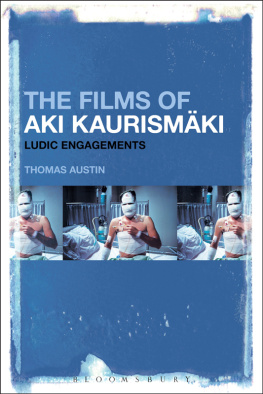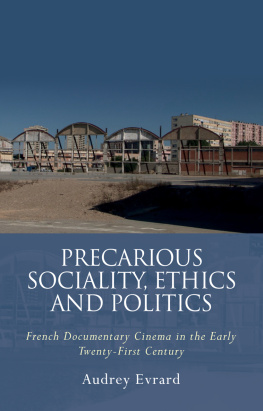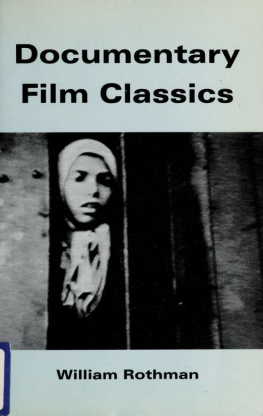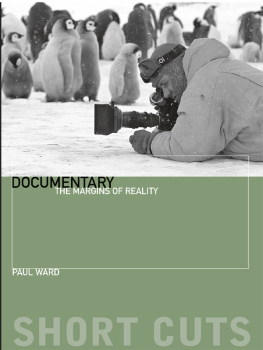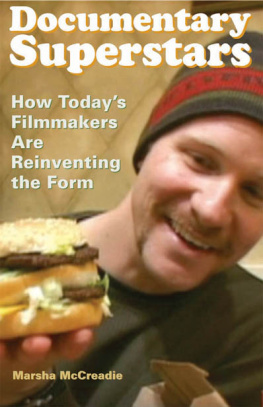Watching the world
For Guy and Noah
Watching the world
Screen documentary and audiences
Thomas Austin
Copyright Thomas Austin 2007
The right of Thomas Austin to be identified as the author of this
work has been asserted by him in accordance with the Copyright,
Designs and Patents Act 1988.
Published by Manchester University Press
Oxford Road, Manchester M13 9NR, UK
and Room 400, 175 Fifth Avenue, New York, NY 10010, USA
www.manchesteruniversitypress.co.uk
Distributed exclusively in the USA by
Palgrave, 175 Fifth Avenue, New York,
NY 10010, USA
Distributed exclusively in Canada by
UBC Press, University of British Columbia, 2029 West Mall,
Vancouver, BC, Canada V6T 1Z2
British Library Cataloguing-in-Publication Data
A catalogue record for this book is available from the British Library
Library of Congress Cataloging-in-Publication Data applied for
ISBN 978 0 7190 7689 3
First published 2007
16 15 14 13 12 11 10 09 08 07 10 9 8 7 6 5 4 3 2 1
Typeset
by Frances Hackeson Freelance Publishing Services, Brinscall, Lancs
Printed in Great Britain
by Bell and Bain Ltd, Glasgow
Contents
Acknowledgements
Special thanks to Charlotte Adcock, as always, for critical insight, advice, love and support; Matthew Frost at MUP for believing in this book; Mike Stones for doing a great job very quickly; Lee Grieveson for 15 years of friendship, and for making me go the extra mile: your questions and suggestions improved this book immeasurably.
Thanks also to Margaret Adcock, Guy Austin, Roger Austin, Sue Austin, Helen Branwood, Rachel Davies (for introducing me to the book of Touching the Void), Eric Faden, Ian Huffer, Geoff King, Peter Krmer, Joanne Lacey, Hannah Lowe, Ernest Mathijs, Andy Medhurst, Sean Mendez, James Montgomery (for your friendship and cuttings service, and for taking me to see Grizzly Man), Anna Nathanson, Mick OMalley, Paul Petit, Sue Thornham, Dolores Tierney, Ana Vicente, Paul Ward, Brian Winston, and to Dorothy Sheridan, Sandra Koa Wing, Karen Watson and Simon Homer at the Mass Observation Archive, University of Sussex.
Research undertaken via the Mass Observation Archive, and a research trip to the Sheffield International Documentary Festival in October 2005, were funded by the Research Fund of the School of Humanities, University of Sussex.
Finally, thanks to all those who participated in audience research projects for this book.
An earlier version of appeared as Seeing, feeling, knowing: a case study of audience perspectives on screen documentary, published online in Participations, 2:1, August 2005.
Introduction
Anglophone screen documentary has experienced a marked rise in visibility and popularity since the late 1990s. This book is both a response to these developments and a contribution to them, insofar as it attempts to extend the reach of documentary studies. It does so by pursuing a critical inquiry into some recent instances of screen documentary, and the uses and possibilities that they offer audiences. What can such an analysis discover about how viewers engage with documentary?
I consider documentaries viewed at cinemas and on home video and DVD, as well as television programming. The primary focus of the book is on mainstream British and American screen material, although it does also offer a case study of British viewers watching a French film. My intention has been to explore not only documentary texts, but also some of the commercial, discursive and social contexts in which they circulate and are watched, and the expectations and responses of some of their audiences. Watching the World proceeds by putting all these objects of study side by side, and analysing points of contact between them, rather than by isolating each as discrete and entirely separate from the others. Case studies focus on the interfaces between textual mechanisms, promotional tactics and audiences viewing strategies. In the process, I investigate topics such as film and televisual form; the cognitive, sensory and emotional rewards of watching documentary; truth claims and issues of trust; and documentary ethics.
Of the three fields raised above texts, contexts, and audiences for documentary it is, rather predictably, the latter that has had the least academic attention. Since the early 1990s, screen scholarship has been energised by a renewed interest in documentary. This is fairly typical of the lack of academic interest in viewers responses to, and uses of, documentary.
Screen documentary is generally organised around the expansive promise of delivering what Bill Nichols has called views of the world. It seems odd, then, that scholarly work on this mode has for so long ignored one crucial way in which documentaries exist in the world via audiences engagements with them. Hopefully, this book will provide an example of some of the insights that can be achieved by turning attention to this unaccountably neglected object of study. Investigations like this are long overdue if viewers of documentary are to be treated with the seriousness with which audiences for screen fictions are now being addressed.
The politics of location
Ideas of location, both literal and figurative, are central to my analysis. If documentary is about gaining mediated access to the world, where exactly is this world in relation to the audience? How is it framed and represented, and how is it to be apprehended from the standpoint of viewers, both presumed and actual? How might notions of the near and the faraway, of the familiar and the
These abiding concerns connect the case studies developed in this book. For instance, an unthreatening geographical distance contributes to the pastoral appeal of rural France for some British viewers of Etre et avoir (France, 2002), whose Francophilia can be considered as a classed disposition. Class is also central to my discussion of the white trash representations deployed in the Paradise Lost films (US, 1996 and 2000), which attends to classed locations (including my own) and disjunctions, as well as issues of spatial separation. The chapter on Touching the Void (UK, 2003) examines how a geographically remote mountain-top adventure of risk and survival can be appropriated as a source of inspiration for the more quotidian demands of everyday life. In the case of Capturing the Friedmans (US, 2003) the family home, the mythical locus classicus of security and comfort, is construed as a site of endangerment and awful secrets, and subjected to criminal investigation and public scrutiny, with audiences invited to judge for themselves what really happened. Finally, my analysis of audiences for wildlife programming considers constructions of the familiar and the exotic, and investigates respondents attitudes towards first-hand and mediated encounters with the natural world.
Debates about the politics of speaking positions and the impossibility of standing beyond them emerged as part of the major epistemological shift associated with the post-structuralist turn in humanities and (some areas of) the social sciences. As touched on in They have also led to an interrogation of academic research as another way of making sense of, and producing knowledge about, the world. As the anthropologist Kirsten Hastrup has observed:


